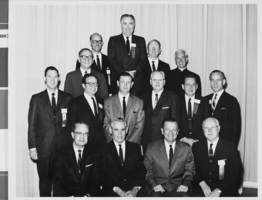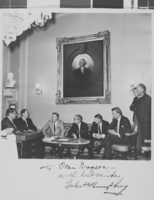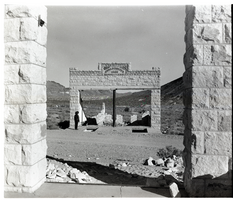Search the Special Collections and Archives Portal
Search Results

Photograph of Mayor Oran K. Gragson and other attendees of the International Exposition of Flight and General Aviation Conference, circa 1960s
Date
Archival Collection
Description
Image

Photograph of eight men seated under a portrait of George Washington, 1967
Date
Archival Collection
Description
Image

Film transparency of the ruins of the H. D. and L. D. Porter Brothers Store, Rhyolite, Nevada, November 25, 1948
Date
Archival Collection
Description
Image
Nanyu Tomiyasu oral history interviews
Identifier
Abstract
Oral history interviews with Nanyu Tomiyasu conducted by Robert McCracken on January 18, 2000, February 05, 2000 and April 02, 2000 for the Women's Research Institute of Nevada (WRIN) on behalf of the Tule Springs Preservation Committee. Tomiyasu opens his interview by discussing his father's immigration journey from Japan to Las Vegas, Nevada. Tomiyasu then describes his father's career in Las Vegas as a vegetable farmer. He talks about the process and challenges his father faced as a farmer in Nevada, and the techniques he used to maintain his land. Tomiyasu then discusses taking over his father's farm, racial discrimination the family faced, and the farm's purchasing agreements with local grocery stores. He also talks about the water systems his farm and the surrounding area relied on, as well as the animals that lived in the area. Tomiyasu ends his interview by discussing his mother's life story and his wife and children.
Archival Collection
Florence and Jerry Vallen Faculty Papers
Identifier
Abstract
The Florence and Jerry Vallen Faculty Papers (approximately 1935-2017) are comprised of personal papers and research files for Florence and Jerry Vallen, the founding dean of the College of Hotel Administration at the University of Nevada, Las Vegas (UNLV). The collection includes research files and drafts for
Archival Collection
Richard and Sheilagh Brooks Papers
Identifier
Abstract
The Richard and Sheilagh Brooks Papers (1919-2003) are comprised of materials collected during their tenure as professors of Anthropology and Archaeology at the University of Nevada, Las Vegas (UNLV). Included are correspondence, research papers, photographs, reports, books, article reviews, and student scholarship. There is also a file on reburial issues that contains correspondence and an amendment to Nevada State law regarding the handling of exhumed bodies.
Archival Collection
UNLV Libraries Collection of MGM Mirage Corporation Promotional Materials and Reports
Identifier
Abstract
The UNLV Libraries Collection of MGM Mirage Corporation Promotional Materials and Reports includes promotional materials, newspaper and magazine clippings, financial reports, annual reports, diversity reports, press releases, and press kits for the MGM Mirage Corporation in Las Vegas, Nevada, dating from 1973 to 2007.
Archival Collection
UNLV Libraries Collection of Showboat, Inc. Promotional Materials and Financial Reports
Identifier
Abstract
The UNLV Libraries Collection of Showboat, Inc. Promotional Materials and Financial Reports includes annual reports, quarterly financial reports, equity research reports, Securities and Exchange Commission Form 10-Q, Securities and Exchange Commission Form 10-K, prospectus, press kit, press releases, promotional materials, and newspaper and magazine clippings for Showboat, Inc. based in Las Vegas, Nevada, and Atlantic City, New Jersey, dating from 1968 to 2002.
Archival Collection
Tonopah Mining Company Records
Identifier
Abstract
The Tonopah Mining Company Records derive from the office of the company’s general manager in Tonopah, Nevada and consist of documents directly generated by its mining and milling operations from 1901 through 1941. The collection includes daily work reports, assay reports and certificates, employee time cards, invoices and receipts for mining equipment and supplies, monthly stores reports, and the company’s numerous insurance policies. Several of the company’s annual reports, including an original typescript copy of the 1907 annual report, are included in the collection. Additionally, select records from the company's subsidiary, Desert Power and Mill Company, as well as the Tonopah and Goldfield Railroad, which include overcharge claims, freight and repair bills, and delivery receipts are included in the collection.
Archival Collection
Aplin Family Scrapbooks
Identifier
Abstract
The Aplin Family Scrapbooks (1927-1971) consists of four handmade scrapbooks compiled by Hilda Aplin. The scrapbooks contain photographs, correspondence, newspaper clippings, and handwritten captions. The majority of the collection focuses on Hilda and Charles Aplin’s involvement in the Fraternal Order of Eagles and Las Vegas Eagles Auxiliary #1213. Also included is a photograph album that details the family’s activities from 1927 to 1959, including notable locations around Las Vegas, Nevada such as Lake Mead, Hoover Dam, Mt. Charleston, and annual Helldorado parades.
Archival Collection
